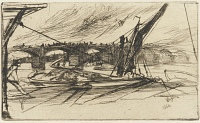Etchings Institutions search term: victoria albert museum
Vauxhall Bridge | ||
| Number: | 75 | |
| Date: | 1861 | |
| Medium: | etching and drypoint | |
| Size: | 69 x 114 mm | |
| Signed: | 'Whistler.' at lower right | |
| Inscribed: | '1861' at lower right (G.2) | |
| Set/Publication: | no | |
| No. of States: | 2 | |
| Known impressions: | 36 | |
| Catalogues: | K.70; M.70; T.46; W.66 | |
| Impressions taken from this plate (36) | ||
KEYWORD
TITLE
'Vauxhall bridge' (1870s, Whistler). 2
'Vauxhall Bridge' (1874, Ralph Thomas, Jr (1840-1876)). 3
3: Thomas 1874 , (cat. no. 46).
DESCRIPTION
SITE
DISCUSSION
There is no actual proof that Whistler was familiar with the work of Hiroshige at this date. Spencer suggested that a reference to 'a Japanese book of painting' in Whistler's possession in 1864 could refer to Hiroshige's woodcuts. 5 However, although Whistler did own a number of Japanese books, paintings and prints, his earliest acquisitions were sold at the time of his bankruptcy and are impossible to identify.

Hiroshige, Clearing weather at Shibaura (Shibaura no seiran), ca 1837-1838, coloured woodcut.
Whistler Collection, The Hunterian, University of Glasgow.
At a later date - after 1880 - Whistler certainly owned a relevant print by Hiroshige, Clearing weather at Shibaura (Shibaura no seiran) from the series Eight Views of the Edo Environs (Edo Kinko Hakkei no uchi) but it is not known when that was acquired. 6
4: i.e. British Museum 1906,1220,0.696. Laurence Binyon, A Catalogue of Japanese & Chinese Woodcuts ... in the British Museum, London, 1916 (no. 464). www.britishmuseum.org (acc. 2012).
5: A.M. Whistler to J.H. Gamble, 10-11 February 1864, GUW #06522. Spencer 1989 , p. 72.
6: GLAHA 54221.
7: Lochnan 1984 , p. 123.

